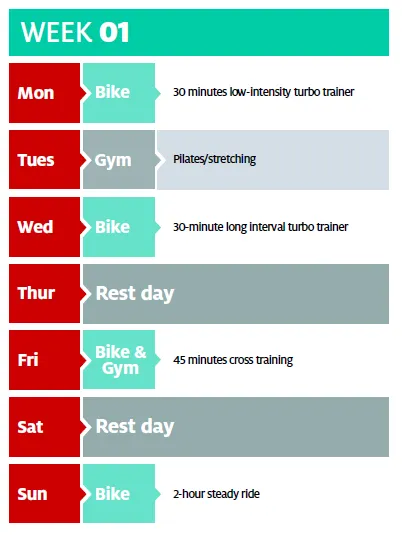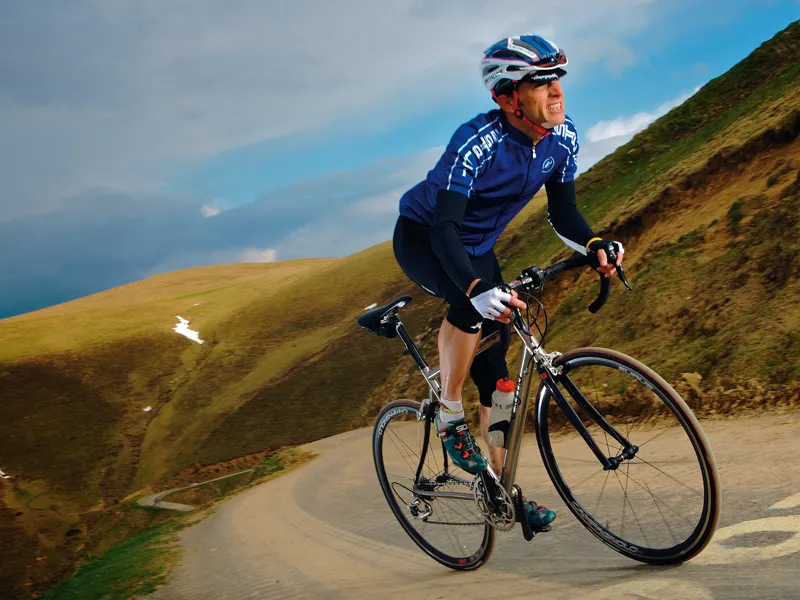You’ve started your training regime and paid the entry fee for that big event, now it’s time to step up the momentum, says coach Chris Ford, of CycleActive.
As spring starts to roll across the country it’s time to step up your sportive training. Last month we looked at how to kickstart your training. This time we’ll be looking at the next phase of your training plan – the early season. This is when the effort and commitment required really start to increase as you prepare for the duration and intensity of the big ride ahead.
The four-week plans further down this page focus on three different groups of riders – novices, enthusiasts and minimalists – and follow on from those in part 1. If you haven’t started preparing for your sportive yet but want to get going then don’t panic: you still have time. Just select a regime that best suits your level and ease into it, using the lower intensity rides only for the first two weeks.
10 more steps to success
1 Manage intensity: With last month’s four-week training period completed you’re probably feeling fitter, faster and better already. It’s at this point that overtraining can often begin. As you feel the drive to improve there’s a temptation to think every bit of extra exercise is going to help. Don’t go beyond the plan, however good you feel, and ensure you still take rest days and sleep well.
2 Refine targets: Last time, we talked about creating targets, but with some miles under your belt it’s time to set more specific short term goals to keep motivated. Target setting is all about ensuring that you stay on track both mentally and physically, so if you can create them to fit with your eventual aim or event, do. Try hitting bigger distances on weekend rides, joining a higher level club ride or shaving time off a favourite hillclimb.
3 Spin to win: Getting fitter will have a greater impact on performance if you become more efficient. As you cover more distance on your training rides, the impact of good pedalling technique will increase. You need to apply power on every part of the stroke, so work on this during turbo trainer warm ups and warm downs, then focus on getting it right on the road. As fitness and strength increase it’s easy to start ‘pushing the pedals’, so focus on spinning in circles, pushing the foot forwards, dipping the heel as you sweep down and back, then flexing again at the ankle as you pull up.
4 Bike setup: This links in to the last point about pedalling, but also affects your comfort and control as rides get bigger. If the saddle is too high you’ll be pedalling on your toes, which reduces power output (you can only push and pull) and tightens calf muscles and hamstrings. Also consider fore and aft adjustments on the rails – a plumb line from the front of the kneecap should line up with the centre spindle of the front pedal with the cranks level, or fall slightly behind it. At the cockpit you might want to tweak bar height, stem length, grip thickness or brake position – anything uncomfortable needs to be fixed now, while you have time to experiment and then get used to the final settings.
5 Develop stretches: Greater workout intensity will increase the risk of injury if you fail to keep your muscles in good condition. Do at least 10 minutes of maintenance stretching after any session. Also make time for a period of developmental stretching, lasting 30 minutes or more, following a gentle warm up with long duration stretches. For each stretch, reach the point where you can feel it without discomfort and hold for 30-40 seconds until the muscle relaxes. Increase gently until you can feel it again without pain, and hold for a further 30-40 seconds. Do this for calves, hamstrings, quads, glutes, adductors and hip flexors.
6 Heart rate: Last issue we talked about varying levels of training intensity. If you want to take this a step further then get a heart rate monitor and work out your target heart rate for each level of activity. This can really help your training but getting the setup right is important. There’s a great article on BikeRadar about finding your maximum and resting heart rates (tinyurl.com/66uwe8w). Everything else stems from these numbers.
7 Weight: Increasing levels of exercise (especially long, steady rides) boosts fat burning. This increases appetite significantly. It’s worth getting scientific about your ideal cycling weight; your GP can help identify your Body Mass Index but it might not give you a clear or accurate target weight. Take advice from a sports nutritionist or count calories, cutting out unhealthy snacks and reducing fats. One habit some riders develop is eating too much on long, steady rides because they feel hungry. In fact, good hydration from sports drinks is all they need.
8 Event logistics: Your main event is two months away and you need to be sure things run smoothly. If you’re travelling far then think about how rested and ready you want to be on the morning of the ride. For big events you might be on a campsite, or need to book accommodation soon. Even check out restaurants so you can book your table for the night before the ride. Everything that can be done now should be, so you can focus exclusively on the cycling as the event draws near.
9 Descending and cornering: A big ride isn’t just about fitness, it’s about technique and safety as you fly down the mountains. Whether it’s the endless descents of the Etape or the steep, twisty roads of the Fred Whitton in the Lake District, you need to be able to handle yourself downhill. On the straights, stand just off the saddle with flexible, relaxed legs to absorb the road, cranks level for even weight distribution, and vision well ahead to plan your line. In the corners, stay off the saddle, drop the outside foot and put most of your weight on it. Steer a smooth line, lean the bike under you, look for the exit of the turn and keep weight equal front and back for maximum grip.
10 Training diary: All this information is too much to hold in your head, so keep a diary and use it to monitor your development. You should log resting heart rate, weight, sleeping patterns, training times against targets, how you feel and any other details you might want to refer back to. Diaries can help you spot when things aren’t working, often before they go too far, and motivate you when you can see clear progress.
Training plans
1) Novice
The last four weeks of training will have paved the way for a step-up in effort and intensity. Coming into cycling events as a moderately fit novice, it’s still important not to push too hard too soon. The aim is to get your first sportive completed, and for you to enjoy it.
Weeks five to eight of training will continue to develop your endurance using low intensity workouts. The change here is that we also want to develop your ability to sustain a higher speed of riding for longer periods. This means making some changes to elements of your weekly plan.

Week 2 (build): Up the long interval turbo and Sunday ride by 15 minutes.
Week 3 (push): Increase again by 15 minutes each.
Week 4 (recover): Return to level of week 1. If tired, miss the cross session.
2) Enthusiast
The early season training needs to push your ability to hold speed through progressively longer rides. This is also the time to start working harder on your burst speed for sprints and short, snappy climbs, without losing focus on the endurance needed for sustained rides of 100 miles or more. At this point a heart rate monitor is extremely useful, so percentages of maximum heart rate (MHR) are covered in the plan.

Week 2 (build): Increase the interval lengths by a minute in the Monday turbo session and add 30 minutes to the Saturday ride.
Week 3 (push): Decrease the recovery period in the intervals by a minute.
Week 4 (recover): Return to the level of week 1. Miss Thursday turbo session.
3) Mnimalist
You’re a keen but time-strapped cyclist, so the need to step up training will require some creative time management. The long, steady workouts are still needed if endurance is going to hold out for a big event, but you need to do more work on sustained speed and start looking at burst times for sprints and short hillclimbs. These aren’t a perfect substitute for endurance but they’re an important part of the programme.

Week 2 (build): Increase the interval lengths by a minute in the Monday turbo session and add 30 minutes to the Saturday ride, if you can.
Week 3 (push): Decrease the recovery period in the intervals by a minute.
Week 4 (recover): Return to level of week 1. Miss Monday turbo session.
Understanding your training plan
Our training plans are built around a 12-week run-up to a major event. This is split into four-week phases: Pre, Early and Peak seasons. The increase in activity level happens like a wave, with the level going up over three weeks then dropping back for a recovery week, before moving to the next phase.
Intensity: The intensity level of training is defined as ‘low’, ‘medium’ and ‘high’. In pre-season the focus is still on low intensity work to continue building endurance and in particular increase your aerobic fitness. This is the bedrock of sportive riding – developing heart and lungs so they can efficiently deliver oxygen to your working muscles. At this stage we also introduce some mid intensity work to start developing speed and the ability to sustain that speed.
At mid intensity you're operating just below your anaerobic threshold – the point at which your heart and lungs can no longer keep up with the oxygen your muscles need to function properly. This can be tested scientifically, or you can aim to be working hard enough that conversations are possible but in short sentences only, and you are never getting ‘puffed out’ (start to breathe/blow more rapidly to expel CO2) which is a sign of excessive CO2 production due to anaerobic activity.
Cross training: Cross training is any non-bike exercise and it's useful to ensure that this covers a wide range of muscle groups to keep you in overall good shape. One round-the-world cyclist said that all of his pre-ride training was on core strength, including arms and most of the upper body, because he wanted to avoid strain or injury from so many miles in the saddle. He said he got bike fit once the ride began!
Turbo trainer: Turbo sessions can serve a range of purposes – a standard session is a good low intensity steady ride when the weather is too bad or nights are too dark to go outdoors. Long interval sessions should be about 6-8 minutes at medium intensity followed by an easy spin at low intensity for 4 minutes to recover. With all sessions, aim to maintain a good cadence of 80-100rpm and a smooth, steady cycling rhythm.
Low intensity flexible training: If you have limited time then developing your aerobic system through long workouts is not an option. Instead you need to find one hour a day that you can use effectively to raise your heart rate – it could be a solid hour of rapid walking at lunchtime, a Sunday dog walk, or an extension of your cycle ride home from work. It’s about stealing snippets of time that add up to a real training benefit.
